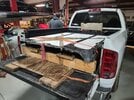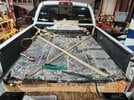I am currently facing an interesting problem that I thought might be worth sharing with the community.
A few weeks ago, I bought a clean title Model 3 LRRWD with FSD and 143k miles for $23k. The main catch was a HV battery with significant imbalance (one brick was 3.50V with all others at around 3.73V). Therefore, the maximum range was about 60 miles, and deteriorating quickly.
Tesla wants $17.5k to replace the pack (which they keep). I wanted to see if I could do it for cheaper, and I also wanted to learn something new.
Removing the pack was not too difficult, just time consuming. I can explain this process in more detail, if desired.


Removing the necessary penthouse components before pack lid removal was time consuming, mainly because I wanted to be careful because of HV and because I hadn't done this before. I can also attempt to explain this in more detail if desired.


Lid removal itself is relatively easy, there is only glue around the outside edge (unlike the Model S/X), and it can likely be reused.

Measuring the voltage of each module showed that module 4 (far right) had a lower voltage by around .23V, so that's the one I removed. This module has 23 bricks in series containing 46 cells in parallel.
Once removed, finding the bad brick location was possible by measuring the voltage at pads at the top of the module. The tops of the modules are not really meant to be removed and wouldn't be very useful anyway, so I rotated the module to the bottom side.
The bottom side is covered by a form of expanding foam/potting compound. I am not sure if it is for fire resistance, vibration resistance, or both, but it flakes away relatively easy with some plastic spudgers.

The brick is losing around .01V per day, and my main theory is a small internal short in one of the cells. I was hoping that any bad cell would be revealed through FLIR imaging, but I had no luck with this. My secondary theory was a stuck bleed resistor or FET on the battery management board, but I saw nothing on the FLIR there (and my knowledge on this topic is nothing compared to some of the greats here, I don't even know if that's possible).

Any burnt-looking areas are from soldering tests. I had run out of ideas for finding a bad cell except to isolate them by cutting the necessary fusible link, checking the cell voltage, and then soldering the link back together. This is my current roadblock, because soldering doesn't work.
As far as I know, the fusible links are copper with nickel plating. They are very soft and fragile. I cut this one in the middle in an attempt to potentially make it easier to solder back together, but the issue is that the collector plate and cell conduct my soldering iron's heat away too well. I cannot get a good solder joint because of this, and for obvious reasons it is undesirable to continue to heat the cell much with a soldering iron. Tesla uses ultrasonic welding to create very localized, brief heating that does not damage the cells. I do not have that capability.
At this point, I have two main options:
Would love any input (positive or negative), suggestions, or offers for buying my 3 good modules or selling a good LR pack.
Thanks everyone.
A few weeks ago, I bought a clean title Model 3 LRRWD with FSD and 143k miles for $23k. The main catch was a HV battery with significant imbalance (one brick was 3.50V with all others at around 3.73V). Therefore, the maximum range was about 60 miles, and deteriorating quickly.
Tesla wants $17.5k to replace the pack (which they keep). I wanted to see if I could do it for cheaper, and I also wanted to learn something new.
Removing the pack was not too difficult, just time consuming. I can explain this process in more detail, if desired.
Removing the necessary penthouse components before pack lid removal was time consuming, mainly because I wanted to be careful because of HV and because I hadn't done this before. I can also attempt to explain this in more detail if desired.
Lid removal itself is relatively easy, there is only glue around the outside edge (unlike the Model S/X), and it can likely be reused.
Measuring the voltage of each module showed that module 4 (far right) had a lower voltage by around .23V, so that's the one I removed. This module has 23 bricks in series containing 46 cells in parallel.
Once removed, finding the bad brick location was possible by measuring the voltage at pads at the top of the module. The tops of the modules are not really meant to be removed and wouldn't be very useful anyway, so I rotated the module to the bottom side.
The bottom side is covered by a form of expanding foam/potting compound. I am not sure if it is for fire resistance, vibration resistance, or both, but it flakes away relatively easy with some plastic spudgers.
The brick is losing around .01V per day, and my main theory is a small internal short in one of the cells. I was hoping that any bad cell would be revealed through FLIR imaging, but I had no luck with this. My secondary theory was a stuck bleed resistor or FET on the battery management board, but I saw nothing on the FLIR there (and my knowledge on this topic is nothing compared to some of the greats here, I don't even know if that's possible).
Any burnt-looking areas are from soldering tests. I had run out of ideas for finding a bad cell except to isolate them by cutting the necessary fusible link, checking the cell voltage, and then soldering the link back together. This is my current roadblock, because soldering doesn't work.
As far as I know, the fusible links are copper with nickel plating. They are very soft and fragile. I cut this one in the middle in an attempt to potentially make it easier to solder back together, but the issue is that the collector plate and cell conduct my soldering iron's heat away too well. I cannot get a good solder joint because of this, and for obvious reasons it is undesirable to continue to heat the cell much with a soldering iron. Tesla uses ultrasonic welding to create very localized, brief heating that does not damage the cells. I do not have that capability.
At this point, I have two main options:
1. Find a way to repair broken fusible links and to find the bad cell (suggestions very welcome).
- If I find the bad cell, I can cut the links to that and then the brick will only have around 1/46th of a capacity loss. This will almost certainly go out of balance after a few months, so I plan on running leads (attachment to be decided) to the penthouse for easier access to manually bring it into balance every few months or so, I guess. I would then likely have a Model 3 LRRWD with FSD for around $25k plus weeks of my time.
- I don't really know of a great way to find the bad cell (if it even is a bad cell and not a BMB issue, in which case I would really have to go to option 2). If anyone knows a good way to measure current flow without breaking the circuit (maybe like a current clamp that I've used for measuring AC current, but scaled down?), that would be great to know. Otherwise, I guess I need to find a way to fix these links (suggestions very welcome) and continue breaking and fixing until I find the one.
2. Give up, try to sell the good modules, and try to find a good, used pack (1104424-00-_ or 1104422-00-_ ) for ~$10k. and do something dumb with the 1 bad module?
- A good, used pack is not easy to come by. I would expect them to be more plentiful due to parted out salvage cars, but eBay only has 1 or 2 suitable packs available. I believe a software update could essentially serve as the necessary firmware redeploy once the pack is installed, but who knows. Total cost would be around $35k, but the pack should be good for another few years.
"But AlphaTango11, why don't you just replace the one bad module? Even Elon says Model 3s could have a module replaced for $5-7k."
Good question. As far as I know (especially by reading from experts like @wk057, who would likely consider this whole post to be insanity), there is no long term viability for such a repair, if it even works at all. There will always be an Amp-hour capacity difference between cells of different ages, and that will almost always result in an uncorrectable imbalance.
Why Elon tweeted that, I'm not quite sure. I don't think that was even possible on the Model S/X, which would theoretically be even cheaper (1 of 16 modules vs 1 of 4).
"AlphaTango11, you're wasting your time to try to save a few grand, and I wasted my time reading this."
I chose to attempt this out of curiosity (and the fact that option #2 had always existed and would be always cheaper than replacement through Tesla). There was a chance that this could have been a cheap, easy fix if a bad cell was more obvious (thermally, visually, anything really).
Sorry if you felt this post was a waste of time, I just ran out of solutions and also figured that this could be useful if someone was considering doing something similar.
Right now, there are not many Model 3s with a bad imbalance like this, and even fewer that are out of warranty (which goes away after 100k or 120k miles for Model 3). I am hoping to continue updating this thread as I go, but I am a college student and this may take some time.Would love any input (positive or negative), suggestions, or offers for buying my 3 good modules or selling a good LR pack.
Thanks everyone.





